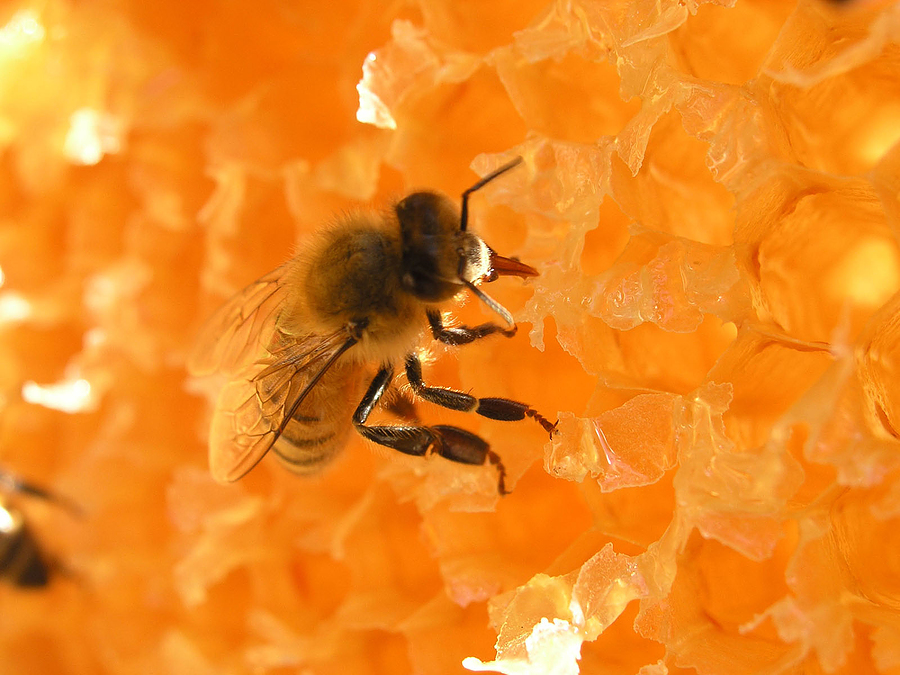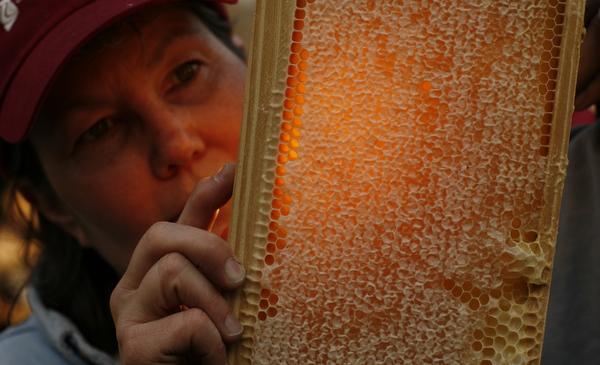The sugar house is stacked high with honey super boxes full of ripe frames of honey. The hardest step in harvesting honey is behind me, so now the sticky fun begins.
Each frame of honey is comprised of an intricate network of honeycomb with each individual cell is filled with honey and the entire frame is sealed with a wax coating. So how does the beautiful block of wax-covered honey get into a jar?
Before extracting begins, the frames of honey need to be warm. It’s always best to extract the honey soon after it is pulled off the hives since the bees keep the inside of their hives between 90º - 100º F. That is the perfect temperature for extracting. But for me, there are times when I just can’t get the entire job done before the weather turns cold, along with my honey frames. When that happens, I will gently and slowly warm the frames using a heat lamp, bringing the temperature back up to about 90º, right where the bees like it.
 And boy howdy, do bees love honey! Honey to bees is like catnip to cats. They are crazy about it. And once they find the stash of harvested honey, they go back to their hive and tell the rest of their family where it is. Then word spreads throughout the entire apiary and everyone joins the party. If they see a vat of liquid honey, they just can’t resist the temptation to dive right in and take a swim. Then their friends follow and they pile on top each other and all of them drown. It doesn’t take long for a tank of honey to be filled with thousands of dead bees. Yes, I learned that lesson the hard way. For this reason it is important to set up the extracting operation inside a tightly-sealed room.
And boy howdy, do bees love honey! Honey to bees is like catnip to cats. They are crazy about it. And once they find the stash of harvested honey, they go back to their hive and tell the rest of their family where it is. Then word spreads throughout the entire apiary and everyone joins the party. If they see a vat of liquid honey, they just can’t resist the temptation to dive right in and take a swim. Then their friends follow and they pile on top each other and all of them drown. It doesn’t take long for a tank of honey to be filled with thousands of dead bees. Yes, I learned that lesson the hard way. For this reason it is important to set up the extracting operation inside a tightly-sealed room.
I do the honey extracting in our maple syrup sugarhouse, which is a great place to make a sticky mess since this room is precisely designed to be used for that purpose. But sadly this room does not have the luxury of tightly sealed doors. Therefore, after the bee-drowning experience a few years ago, I need to keep my honey super boxes tightly sealed until I’m ready to extract. Then I’ll do all of the extracting at night or on windy or rainy days when the bees aren’t out foraging. But even with these precautions, there will always be a few bees buzzing around while the extracting process in progress.
To access the honey, the wax cappings need to be removed. I use an electric uncapping knife which is a hot metal blade that makes it easy to cut a thin slice across the top surface of the honey. As I slice, the top layer drops into the vat of the uncapping tank, which has a screen in the bottom to allow the honey within the wax to leach out to be eventually drained from the tank. Beeswax is also saved and rendered for future use.
The uncapped frames are vertically placed into the extractor, which is a tank with racks on the inside to hold the frames in place while they spin. Using centrifugal force, the honey flings out of the comb, splatters to the sides of the drum, runs down and pools in the bottom where it is drained out of the tank. The process is similar to the spin cycle on a washing machine. Extractors range in size and capability. Some are small and have a hand crank to spin the frames, while others are much larger, hold many frames and are motorized. My extractor is motorized and holds 18 honey super frames, and the process takes about 20 minutes per batch.
After spending 20 minutes being vigorously spun in circles, you may think that the honeycomb on the frames would be completely destroyed. But that doesn’t happen. All of the beautiful honeycomb stays securely in tact, and the frames are ready to be put back on the hives for a refill next season.
As the honey is drained from the extractor, I use a sieve to catch the debris such as large chunks of wax or the occasional dead bee that found its way into the tank. At this point, some beekeepers may choose to filter and process their honey even further so it stays clear and liquid. I choose not to do that, keeping the honey as raw and natural as the bees have made it.
I pour it all into the bottling tank that has a spout at the bottom where each jar is filled one at a time. I like to use the old fashioned glass honey jars because it emphasizes the beauty of the honey. Plastic honey bears are a very popular container, not only because they are cute, but it’s easy to squirt the honey out of the spout on the little bear’s head.
Sadly honeybees around the world are greatly challenged and continue to decline. Beekeepers are equally challenged as they struggle along with their bees. They need your support, so take time to find and support a local beekeeper, eat local honey and celebrate this amazing product of nature.
Main photo by Mitch Kezar

Debbie Morrison is a frequent contributor to Simple, Good and Tasty. She and her husband Jim own and operate Sapsucker Farms, where their certified organic crops include maple syrup, honey, apples, plums and vegetables. Debbie's last post for Simple, Good and Tasty was Honey Harvesting 101: Smoke, Stink, Blow, Brush.




